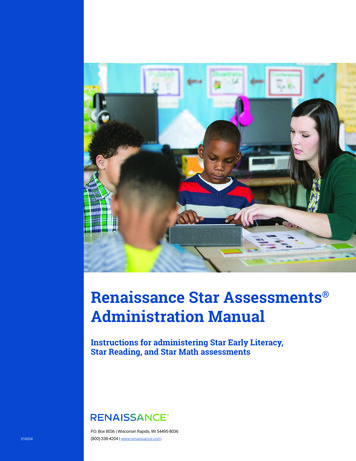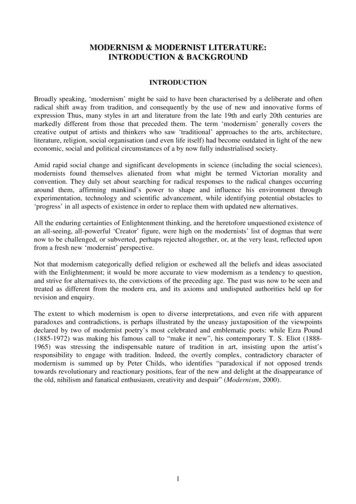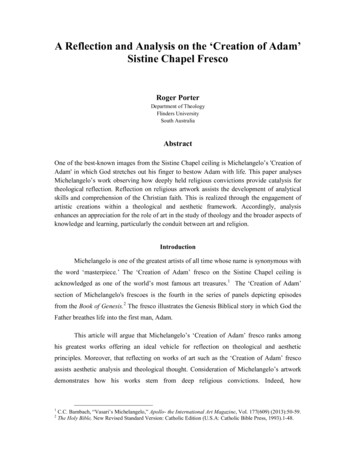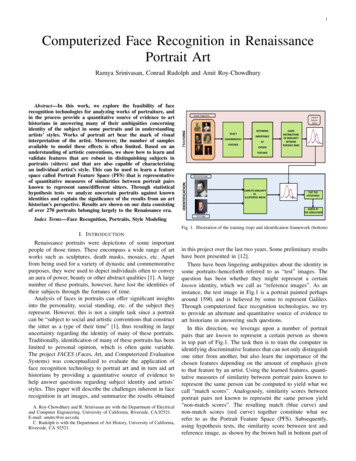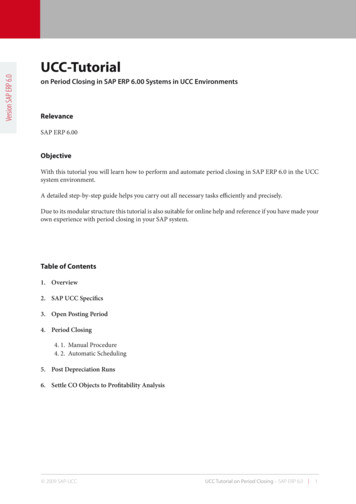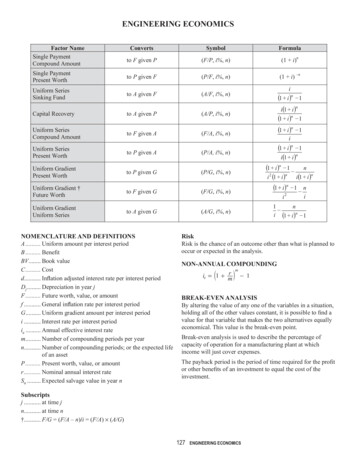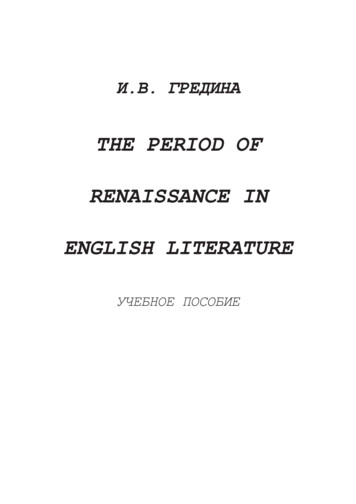
Transcription
И.В. ГРЕДИНАTHE PERIOD OFRENAISSANCE INENGLISH LITERATUREУЧЕБНОЕ ПОСОБИЕ
UNIT I. THE RENAISSANCE1485-1649Renaissance means re-birth. From about 1500 to 1600 the world wasreborn in many ways. The Renaissance began in Italy, especially in art andarchitecture, in the fifteenth century. As England became the most powerfulnation in Europe in the late sixteenth century, new worlds were discoveredand new ways of seeing and thinking developed. Columbus discoveredAmerica in 1492, Copernicus and Galileo made important discoveries aboutthe stars and planets, Ferdinand Magellan sailed all round the world. TheRenaissance was worldwide.HISTORICAL BACKGROUNDIn England there was an important change in religion and politics whenKing Henry VIII made himself the head of the Church of England, bringingchurch and state together (1529-39). He cut all contact with Catholic Churchand the Pope in Rome, part of a reaction against the Catholic Church in manyparts of Europe. Protestantism became more and more important and gave awhole new vision of man’s relations with God. The king or queen became thehuman being on earth who was closest to God, at the head of the Great Chainof Being which led down to the rest of mankind, animals, insects and so on.The Dutch thinker, Erasmus, wrote of mankind as central to the world, andthis humanist concern was the basis of most Renaissance thought.The Tudors inherited much of the medieval view of the world whichconsisted of numberless but linked ‘degrees’ of being, from the four physicalelements ( air, fire, earth and water) up to the pure intelligence of angels.Also, the whole universe was governed by divine will; Nature was God’sinstrument, the social hierarchy a product of Nature. Everything had theirnatural place in the unity of the whole: both within the family and state (whichit is believed, should be governed by a single head). At the same time, thisorder, which was founded on Nature, existed for man’s benefit, and man wasan integral part of it. His godlike qualities had, unfortunately been ruined bythe Fall (as described in the Bible) and he was constantly troubled by suchthings as wars and plaques. Nevertheless, provided that he treated this worldas preparation for the next, and, with the help of human reason, he kept hisbody subject to his soul; he had it within his powers to enjoy civilizedhappiness.Daugther of Henry VIII and Anne Boleyn, Queen Elisabeth(1533-1603),became the symbol of the Golden Age, the period of stability from 1558 to1603. Following her mother’s execution, Elizabeth was declared illegitimateby parliament (1537), and suffered a lonely childhood, much of it spent in thecompany of her young brother Edward. She was rigorously educated, studying4
Latin and Greek. The accession of her sister as Mary I in 1553 increased theinsecurity of Elizabeth’s position, she was an opponent of religiousextremism, she was seen as natural focus for the protestant faction. Accusedof involvement in Sir Thomas Wyatt’s rebellion, she was imprisoned in Towerbefore being placed under house arrest at Woodstock (1554).At her accession in 1558 Elizabeth inherited a nation deeply divided byreligious strife. She set about restoring the moderate Anglicanism of herfather: Mary's grants to the Roman Catholic orders were reclaimed; theAnglican service was reintroduced (1559). Economic reforms included thecalling in of the debased coinage of the previous three reigns. Elizabethappointed as her chief secretary William Cecil, who remained her trustedadvisor and friend until his death in 1598. Parliament, anxious to secure theProtestant succession, urged her to marry but she refused, although throughouther reign she used marriage as a diplomatic counter in her relations withFrance. She conducted romantic relationships with a number of men, forexample, with Robert Devereux, earl of Essex.As prudent financially as she was cautious diplomatically, Elizabethfinanced government from her own revenues and called Parliament to votesupplies only 13 times during her reign. Her management of Parliament wasmarked by a willingness to compromise and demonstrated a political skilllacking in her Stuart successors. By her evident devotion to the welfare of hersubjects, she helped create a national self-confidence that bore fruit in the last15 years of her reign, notably in literature and in the works of such writers asMarlowe, Spencer and Shakespeare.Being the last monarch of the House of Tudor, Elizabeth was a Protestant(a term used for those who broke away from the Roman Catholic Church).Her predecessor, Mary I (on the throne 1553-1558), had been a repressiveCatholic, married to the most fanatically Catholic sovereign in Europe, PhilipII of Spain). Although Elizabeth cut the ties with Rome, her tolerance and herability to compromise won her the loyalty of both Catholic and Puritans(Protestant reformers who insisted on simplicity in religious forms). In 1588Philip’s attempt to conquer England led to the defeat of great Spanish fleetknown as the Armada. Sir Francis Drake (1540-1596), a national hero, wasone of the commanders of the English fleet. This victory was a great triumphfor Elizabeth and through her nation. England’s enemies, Spain in particular,were defeated, and the English controlled the seas of the world, exploring andbringing valuable goods from the New World. This was closely linked withthe Renaissance search for new ways of believing, new ways of seen andunderstanding the universe.The Renaissance was the beginning of the modern world in the areas ofgeography, science, politics, religion, society and art. London became not5
only the capital of England, but also the main city of the known world. AndEnglish, in the hands of writers like Shakespeare, became the modernlanguage we can recognize today. The invention of printing meant that allkinds of writing were open to anyone who could read. Many new forms ofwriting were developed. But the most important form of expression wastheatre. This was the age of Shakespeare, and the Golden Age of EnglishDrama.We can distinguish three periods of literature of English Renaissance. Thefirst period covers the end of the 15th and the first half of the 16th centuries. InEngland the first scholars and humanists appeared, they studied andinvestigated the antique philosophy, literature. In Oxford and CambridgeUniversities the first generations of the English humanists were trained, thedevelopment of the book printing was of importance for humanistic culture.The first English printer William Caxton (1422-1491) learnt the art of printingat Cologne in the early 1470-s (Guttenberg in Germany in 1440). In 1470-s hereturned to England. In 1577 the first book was issued from his press atWestminster, Earl ‘Rivers’ ”Dictes and Sayengs of the Phylosophers”.Between them and his death Caxton produced about 80 complete volumes,including Chaucer’s “The Canterbury Tales”, and also found time to work ontranslations.In this period the English humanistic literature was mainly of theoreticalcharacter, Thomas More (1478 – 1535), was the most outstanding writer ofthe first stage of English Renaissance. He was Lord Chancellor of Englandfrom 1529-1532), scholar and saint. He trained as a lawyer, entered parliamentin 1504. He resigned in opposition to Henry VIII’s religious policies and wasarrested for refusing to swear the oath to the Act of Succession and therebydeny papal supremacy. He was convicted on the perjured evidence of SirRichard Rich after a remarkable self-defense and was executed. He wascanonized in 1935. Thomas More was a renowned scholar and a friend ofErasmus, his writings including ‘Utopia’ are a description of an ideal society.His main work “Utopia” was written in 1516 in Latin, the internationallanguage of those times. The book consists of two parts and is written in theform of dialog between Thomas More and a seaman Rafail Hitlodey, thetraveler all over the world. The political system of Europe of those days wassharply criticized in the conversations of the authors and Hitlodey; the wars ofconquest, cruel legislative power against poor, the problems of enclosureswere discussed (The extensive enclosure («огораживание») by landlords ofthe peasants fields was used for sheep farming, the peasants were turned outof their lands by landlords). On this concern Rafail Hitlodey, the seaman,considered that “Sheep devour (eat up) people”. The antithesis to the politicalsystem of Europe is the ideal life on the island Utopia, in Greek it means6
“nowhere”. The picture of life and the society on the island Utopia isimaginary, not real: the political system is democratic, the labour is the mainduty, there is no money at all, but there is an abundance of products; all thecitizens are equal in rights and compose successfully the mental and physicalwork. We still use the word “utopia” to determine something unreal, i.e.unreal society.The second period, the so called Elizabethan one covers the second half ofthe XVI century and the beginning of the XYII. It is the time of flourishingthe English Renaissance literature, the time of creating of the new literaryforms: Shakespeare’s masterpieces are created in this period.The third period – the time after Shakespeare’s death and up to 1640 (theforties of the 17th century), it was the time of declining the EnglishRenaissance literature.UNIT II. THE POETRYOF RENAISSANCE(ELIZABETHAN POETRY)The English poetry of Renaissance developed under the influence ofChaucer’s traditions, folk songs and Italian verse forms. Two commonthemes in 16-th century poetry were the relationship between men andwomen, and the treachery and hypocrisy of courtly life. Many imitators ofChaucer appeared after his death in 1400, but few are of great interest. Morethan a century had to pass before any further important English poetry waswritten. Queen Elizabeth ruled from 1558 to 1603, but the great Elizabethanliterary age is not considered as beginning until 1579. Before that year twopoets wrote works of value.The sonnet becomes a very important poetic form in Elizabethan writing.The sonnet, a poem of fourteen ten-syllable lines, came from the Italian ofPetrarch. The first examples in English were written by Sir Thomas Wyatt,and the form was then developed by Henry Howard, Earl of Surrey, they areoften mentioned together, but there are many differences in their work. Bothwrote sonnets, which they learned to do from the Italians; but it was Wyattwho first brought the sonnet to England. Surrey’s work is also importantbecause he wrote the first blank verse in English. Surrey’s blank verse isfairly good; he keeps it alive by changing the positions of the main beats inthe lines.In the form of the sonnet Waytt mainly followed the Italian poet Petrarch(1304-74). In this form, the 14 lines rhyme abbaabba (8) 2 or 3 rhymes in7
the last 6 lines. The sonnets of Shakespeare are not of this form; they rhymeababcdcdefefgg.Before and during Elizabethan age, the writing of poetry was part ofeducation of a gentleman, and the books of sonnets and lyrics that appearedcontained work by numbers of different writers. The prominent date, socalled milestone in the development of the English poetry was an anthologycalled Tottel’s Miscellany [miscellany selection]. This collection of poems,“ Songes and Sonnets, written by the ryght honorable Lorde Henry Howarde,late Earl of Surrey, and others” (“Песни и сонеты, написанныедостопочтенным лордом Генри Говардом, покойным графом Серрей идругими») was published in 1557. This book of poems is called after itspublisher’s name “Tottel’s Miscellany” («Сборник Тоттеля»), or “Tottel’sSongs and Sonnets”. It contains 40 poems by Surrey and 96 by Wyatt, thereare 135 poems by the other authors.Sir Thomas Wyatt was a popular member of the court of Henry VIII(1509 – 1547) and was often sent on diplomatic missions overseas. However,he was twice arrested, once in 1536 with the fall of Anne Boleyn, Henry’ssecond queen, and again in 1541 with the fall of his patron, ThomasCromwell. Perhaps his first arrest was because he had been Anne’s loverbefore her marriage to the king. Whatever the reasons, he was fortunate toregain the king’s favour. On the second occasion he was charged with treasonand imprisoned in the Tower of London. Wyatt’s verse, essentially Englishbut much influenced by Italian verse forms, was written to be passed – andsometimes sung – among friends at court.Wyatt has left us some good lyrics. Here is part of a lover’s prayer to hisgirl:And wilt thouleave me thus Thathath loved thee solong In wealth andwoe among; And isthy heart so strongAs for to leave methus? Say nay (no)!Say nay (no)!What do you think, did these popular sonnets and lyrics express realfeelings, or were they just poetic exercises? Some are very fine indeed.Imagine, the narrator of the following poem is in prison.8
They Flee from MeThey flee from me, that sometime did me seek,With naked foot stalking in my chamber. I haveseen them, gentle, tame, and meek, That noware wild, and do not remember That sometimethey put themselves in danger To take bread atmy hand; and now they range, Busily seekingwith a continual change.GLOSSARYflee (l.1): run awaystalking (l.2): walking slowly andcarefully as when hunting an animalmeek (l.3): submissiverange (l.6): move freely without controlhath (l.8): (archaic form of «have» usedwith «he», «she», «it»)array (l.10): fine dressThanked be fortune it hath been otherwise,Twenty times better; but once in special,guise (l.10): style of clothingIn thin array, after a pleasant guise,small (l. 12): slimWhen her loose gown from her shoulders didTherewithal (l.13): immediately after thatfall,Thorough (l.16): through,And she me caught in her arms long and small, because of (archaic)Therewithall sweetly did me kissStrange forsaking (l.17): new andAnd softly said, «Dear heart, how like you this?» unusual kind of desertionleave (l.18): permissionIt was no dream, I lay broad waking.newfangleness (l.19): absence ofBut all is turned, thorough my gentleness,loyalty in love, always changingInto a strange fashion of forsaking; And I havekindely (l.20): naturally (withleave to go, of her goodness, And she also to use ironic suggestion of «unkindly»newfangleness. But since that I so kindely am in a modern sense)served, I fain would know what she hathI fain would (l.21): I woulddeserved.kike to (archaic)Who could «they» be? (Friends at court? Women?) Who do you think «she»could be? (His wife? A mistress? A Symbol for friends?)The complaints of a forsaken lover were conventional in the Italian poetry thatinfluenced Wyatt. However, Wyatt’s poems sound direct and personal as thoughthe ‘voice’ of the poem was not only that of a ‘dramatic persona’ (a character in afictional work) but of Wyatt himself. In Tottel’s Miscellany, where the chief worksof the poet were published for the first time, the editors made alterations toWyatt’s rhythms to make them smoother. For example, line 3 became: «Oncehave I seen them gentle, tame and meek».«I have seen them» probably sounded too abrupt to the editors; the original lineonly had 9 syllables instead of ten. Modern critics argue that Wyatt’s rhythms aredeliberately rough: they give the poems dramatic impact.UNIT III.THE SEQUENCE « ASTROPHEL AND STELLA»The XVI century is the golden age of the sonnet form in Western Europe.9
During one century more than 300 thousands of sonnets were written.Perhaps this form with its exactness of the inner structure was attractive forthe poets with their new interpretation of human personality and intellect –the sonnet makes possible to express the author’s feelings and thoughts in acompressive way. Philip Sidney was one of the founders of this tradition ofthe English verse. 400 years ago in London a society was founded, called“Areopagus” headed by Philip Sidney. The members of this society wereEdmund Spenser (1552 –1599), Fulk Grewil. During their meetings religiousand philosophical problems were discussed and new forms of poetry wereworked out. “The Defence of Poetry” («Защита поэзии») by Philip Sydneywas a theoretical work, philosophical and esthetical creed of the new poetryfounders. The main object of poetry after Ph. Sydney is considered to be thepositive influence on the individual’s mentality: it is necessary for the poet tocreate an ideal character; and to convince the reader to believe in such perfectcharacter («совершенство») the writers must face their characters todifficulties and make them improve their souls.The sequence “Astrophel and Stella” (written in the period 1581 –1583 andpublished in 1591)contains 108 sonnets and 11 songs. The young courtierAstrophel is the Greek for ‘star-lover’ it means «влюбленный в звезду».“Stella” – the Latin for ‘star’. Before the discussion the sonnet sequence letus consider some facts from the life of Ph. Sydney and Penelope Devereuxand their relationship. The contemporaries of Sydney believed them to be theprototypes of Astrophel and Stella.Sydney was engaged to Penelope, the daughter of the earl of Essex – whoeventually had a rather unhappy marriage to Lord Rich. For the time Sydneywas engaged to Penelope she was 18-19. Penelope is identified as Stella,although she is said to have been rather less virtuous than Stella.In the history of the development of the sonnet sequence the role of Stellais very important. She is one of the first heroines in the line of femalecharacters of the English lyrical poetry. But nevertheless Stella differs greatlyfrom the traditional female image of the Italian sonnets. She is noble, devotedto her moral duty. In the sequence, Sydney harmonizes his personal tone ofvoice with both myth and narrative; he tells about development of her loveand presents this female character as a positive one. Her virtue is based noton the dream about Paradise love but on the understanding of her moral duty.She is not an ideal image; she is real lively, vivid female character, thepredecessor to the Dark Lady of Shakespearean sonnets written later in 1609.Ph. Sydney realized that Penelope was an outstanding personality and sheprovoked him for creation of female character unknown in English lyricalpoetry. Penelope Devereux possessed all the virtues which were of greatvalue in the court life: her brilliant beauty attracted attention, she waseducated, knew French, Italian, Spanish, took part at the theatrical plays byBen Jonson (1572 – 1637). Even the king James ( who was the King of Scotsin 1567-1625 and of England and Ireland in 1603-1625) noticed her brilliantintellect revealed in her letters. More than other women of her time she tookpart in the court’s political intrigues.10
Her brother, earl Essex was a national hero. He became and remainedElizabeth’s favorite despite his marriage (1590) to Sir Philip Sydney’swidow. Appointed in 1599 to put down O’Neil’s revolt in Ireland earl Essexwas unlucky with his campaign and it was Penelope who wrote an inspiredletter praying to help her brother to the queen Elizabeth. Earl Essex attemptedwithout success to raise a rebellion in London against the government and inthis period Penelope lived in his house. Earl Essex was condemned andexecuted and for high treason and she defended her brother before themilitary Council. Earl Essex was a remarkable personality, the author ofnumerous sonnets; he was a patron of literature, in particular of FrancisBacon, who, however, acted as a prosecutor at his trial. Thus, the life ofPenelope, this remarkable person, was connected with many outstandingpeople of those times.There is no doubt that creating his lyrical sequence Ph. Sidney used allthe achievments of European poetry in this genre. The innovations ofSydney, so called English Petrarch you can see in synthetic character of hissequence “Astrophil and Stella”, in the transformation of the poeticaltechnique. Considering the experience of Wyatt and Surrey’s blank verse,Sydney invented his verse with the rhyme abbaabba cdcdgg. Sixty sonnets ofthe 108 are written in this form – classical Italian octave and sestet, and thetwo lines, so called conclusive one’s are connected syntactically with theformer line and contain the main idea.The range of lexical means Sidney used in his cycle is wide, - he usedcolloquial words, introduced political, military, law terms enriching Englishpoetry and national language in the whole. Sidney used two methods:1.Compound epithets consisting of two or more words. This techniquewas new for the English poetry, Sidney was considered to copy it fromFrench poetry. Writing about peculiarities of the English language Sidneynoted that for his native language “brilliant composition of two or threewords” is characteristic. Unfortunately in Russian translations of the cyclethis method is not always re-created or reproduced. Consider for example the5th line of the 31 sonnet: “Long with Love acquainted eyes”. In Russiantranslation it sounds different: «В любви немало ведал я невзгод».2.The second method is inversion which has emotional and intellectualcharacter and makes the verse more musical and coloured. For example in the11th Song:“Never doth thy beauty flourishMore than in my reason’s sight”,stor in the 1 Song:“Doubt you, to whom my Muse these notes intendeth Only with you not miracles are wonders”.Besides Sydney prefers to use one syllable or two syllable words in his verseand sometimes there is about 10 short words in the line, for example, sonnet31:“With how sad steps, o Moone, thou climb’st the skies”,11
or sonnet 1:“Fool”, said my Muse to me, “Look in thy heart and write ”.It is worth mentioning that this sequence of sonnets is not a poetical diaryof the writer, there are many signs of the time there. By the way, the mostpart of the sonnets are devoted not to Stella but to his friend, to the poets, tothe moon, even to a sparrow, to human virtues, and in the first line thesonnets are addressed to the reader, while Astrophel, Stella and othercharacters are only actors telling about Astrophel’s love to Stella. It does notmatter whether Sydney was in love with Penelope, the main thing is that theimage of Love exists in his imagination.Many English and American literary scholars discussed the questionabout identity of the Astrophil and Sydney’s personalities. The questionabout genre of this sequence of sonnets is challenging. Almost all the sonnetsare written in the first person and it is not easy to differentiate the words ofthe hero and the author. Nevertheless, this sequence of sonnets seems to bethe first attempt of the author to separate himself from his hero and to leadhis hero through the way of moral improvement. Ph. Sydney created a newtype of poetic work, “Astrophil and Stella” differs from former lyricsequences of sonnets in the point, that it is “lyric and epic work”. In the“Foreword” to the first edition of this sequence (1591) Tomas Nash calledthis composition “tragicomedy” of Love. As to his opinion, this sequencewas created to demonstrate moral perfection of a man in the struggle ofpassion and intelligence. The tale about the unhappy love of Astrophildefeated by Cupid begins with his dreams about mutual love, but he mustconfess that his mistress heart is very hard and severe. Astrophel is in despairof the thought that Stella’ heart is closed to him. At last his love foundresponse in Stella’s heart, but her love is only ideal and it does not bring anysatisfaction for Astrophel. Unlike Wayatt, Sydney was not aiming at theexpression of strong personal emotions only, but at something more exaltedand elevated or sometimes connected with military affairs. For example thefollowing sonnet by Sydney refers to an actual tournament held in 1581. Atournament (or “tourney”) was a public contest between armed horsemen inimitation of real battle, based on ideas of chivalry and accompanied by muchpageantry. The field was enclosed by barriers, with pavilions at the side fornotable people.Read and analyze the 41st sonnet, consider it’s Russian translation:by the judgment of the English eyes And ofСонет 41В тот день служили конь, рука, копьеThe 41st sonnet from the sequenceHaving this day my horse, my hand, my lanceGuided so well that I obtained the prize, Both12
На славу мне — моей была наградаsome sent from that sweet enemy, France,Horsemen my skill in horsemanship advance,Town-folks my strength; a daintier judgeapplies His praise to sleight which from gooduse doth rise; Some lucky wits impute it butto chance; Others, because of both sides I dotake My blood from them who did excel inthis, Think nature me a man-at-arms didmake. How far they shoot awry! The truecause is,Stella looked on, and from her heavenly faceSent forth the beams which made so fair myrace.По приговору английского взгляда,И милый враг француз признал ее.Не столь высоко мастерство моеИ не чрезмерна мощь; молва бы радаСчитать, что хитростью взята преграда;Иной приплел удачу самоё.А те, с кем я с рожденья удостоинЕдинокровьем, мнят, кичась родством,Что я Природою взращен как воин. Всеневпопад! Причина только в том, ЧтоСтелла там сияла, и блистанье Менявело к победе на ристанье.Перевод Л.И. Володарской(from Astrophel and Stella)GLOSSARYof both sides (1.9): my ancestors on both sides didexcel in this (1.10): (were distinguished in theskills needed at a tournament)shoot awry (1.12): get it wrong race (1.14): lifeadvance (1.5): speak wellof daintier (1.6): more carefulsleight (1.7): skillgood use (1.7): experienceimpute it but (1.8): only consider it13
Sir Phillip SidneyUNIT IV. THE LIFE OFPHILLIP SIDNEY(1554-1586)Detail of an oil painting, 1576;in the Warwick Castle CollectionBy courtesy of the trustees of the Warwick CastleResettlement, photograph, Courlauid institute of Art, LondonSidney came as close as anyone could to embodying the RenaissanceMan ideal Soldier, scholar, poet, critic, courtier and diplomat, he lived a lifeof both thought and action, adept at not only the gentler pursuits of life, butthe hardier ones as well. He was fatally wounded in a battle in Holland instead of taking the water offered to him, however, he passed it to anotherwounded man, saying, «Thy necessity is greater than mine.»Ph. Sydney, the author of the first English sequence of sonnets, was bornon the 30th of November 1554; he belonged to a noble family being a son ofSir Henry Sidney (a Knight by Edward VI), his mother Lady Mary Dudley,daughter of the Duke of Nothumberland was from the ancient aristocraticfamily, his Godfather was King Philip II of Spain. After Elizabeth Isucceeded to the throne, Sir Henry was appointed Lord President of Wales,while his uncle, Robert Dudley, was created earl of Leicester and became theQueen’s most trusted advisor. In keeping with such a family background, theyoung Sidney was intended for a career as a statesman and soldier.Philip Sydney got an excellent education entering in the age of 10 one ofthe progressive schools of those times, Schrewsbury School headed by theoutstanding scholar Tomas Eshton where his classmate was Fulke Greville(later a court official under Elizabeth) who became his lifelong friend andwas his early biographer. In this School Sidney was taught Latin, Greek,French, he studied the essays by Cesar, Horatio, Virgil.14
In February 1568 he began a three year period of studies at Christ Church,Oxford. There is a version that he studied at the Cambridge University from1568 till 1571) but had to leave it because of plaque epidemy. In May 1572Elizabeth arranged his travelling to the continent for studying foreignlanguages. With the letter of recommendation to the French Ambassador hewent to France, then to Germany (where he met the great Tasso), to Hungaryand Poland. He mastered French, Latin, Italian, Spanish and the brilliantcareer of a diplomat, statesman and military man was opened to him and heknew it studying not only languages, but political, economical and religiouslife of different countries. It is worthy of special mention that all thestatesmen, politicians, military men, nobility and gentry, all the persons heassociated with were protestants. Hewbert Langet, the French lawyer, whoinfluenced greatly the persona;lity of Sidney being his friend and advisor,was protestant too. Sidney also gained firsthand knowledge of Europeanpolitics and became acquainted with many of Europe’s leading statesmen.His first court appointment came in spring 1576, when he succeeded hisfather as cupbearer to the Queen, a ceremonial position. Then, in February1577, when he was only 22, he was sent as an ambassador to the Germanemperor Rudolf II. He was to carry Queen Elizabeth condolences on thedeath of Rudolf’s father. But along with his formal task, he also had secretinstructions to sound out the German Princes on their attitude toward theformation of a Protestant Leaque – the chief political aim being to protectEngland by associating it with other Protestant states in Europe that wouldcounterbalance the threatening power of Roman Catholic Spain.Sidney apparently brought back enthusiastic reports on the possibilities offorming such a leaque, but the cautious queen sent other emissaries to checkon his reports, and they returned with less optimistic accounts of the GermanPrinces reliability as allies. He did not receive another major officialappointment untill 8 years later.He nevertheless continued to busy himself in the politics and diplomacyof his country. In 1579 he wrote privately to the Queen advising her against aproposal that she enter into a marriage with a Duke of Anjon, the RomanCatholic heir to the French throne. Moreover, Sidney was a member ofParliament for Kent in 1581 and 1584-85; besides he was among the fewEnglishmen of this time with any interest in the newly discovered America,he supported maritime explorations by the navigater Sir Martin Frobisher.Later Sidney became interested in the project to establish the Americancolony of Virginia; sent out by Walter Releigh
the English Renaissance literature, the time of creating of the new literary forms: Shakespeare’s masterpieces are created in this period. The third period – the time after Shakespeare’s death and up to 164

